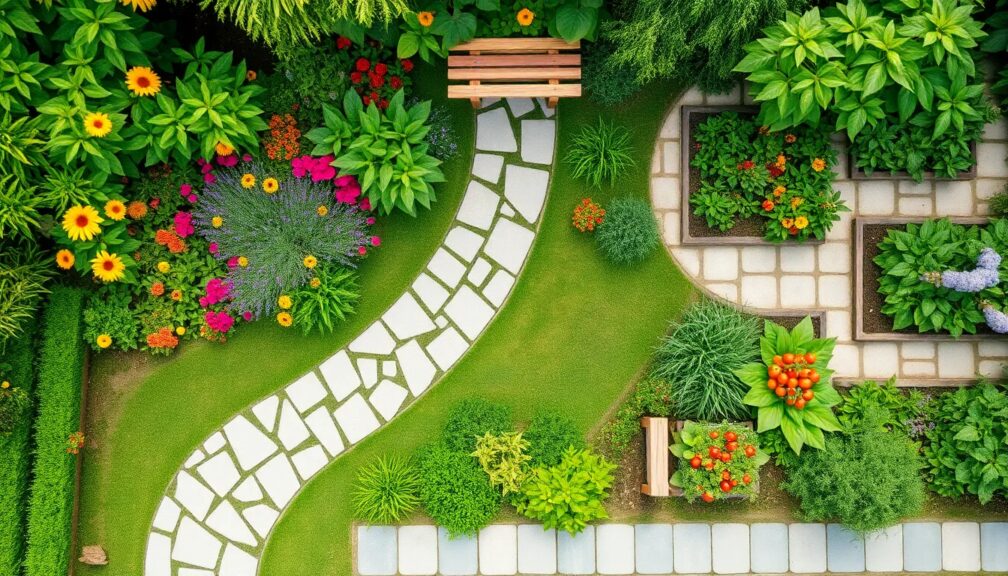How do I plant my garden layout

Welcome to Our Guide on How to Plan Your Garden Layout
Designing the perfect garden layout can be an exciting yet challenging endeavor. Whether you're a seasoned gardener or a budding green thumb, understanding the essential steps in planning your garden can transform your outdoor space into a thriving oasis. From assessing your land and selecting the right plants to considering sunlight patterns and optimizing your space, this guide will walk you through the process of creating a functional and aesthetically pleasing garden. So, get ready to delve into the world of garden planning and bring your dream garden to life.
How to design a garden plant layout?
If you've ever dreamed of creating a garden oasis that captures the essence of nature's beauty, the key lies in the art of garden plant layout. Imagine stepping into your backyard and being welcomed by a symphony of colors, textures, and fragrances that sweep you away to a place of tranquility and wonder. It's not just about planting a few flowers; it's about designing a living tapestry that evolves with the seasons.
To transform your green space into a mesmerizing retreat, you'll need to dive into the principles of layout design. Consider the sun exposure and soil conditions in your garden; these will be the canvas for your horticultural masterpiece. Armed with this knowledge, you can select plants that will thrive and contribute to a harmonious landscape.
Think of your garden as a stage where each plant is an actor playing a role. Start with anchoring the space with structural plants, like trees and shrubs, to set the scene. Then layer in flowering perennials and annuals to add depth and movement. Don't forget to incorporate evergreens for year-round interest.
But, the secret sauce that will truly make your garden layout stand out? That's right, it's the personal touches that reflect your unique style. Whether it's a winding pathway, a hidden bench, or a creatively placed garden sculpture, these elements invite exploration and surprise.
The journey to a breathtaking garden is one of both planning and creativity. Stay tuned for our next segment, where we'll reveal the top plants that command attention and how to pair them for maximum impact. Ready to embark on this garden design adventure? The path to your dream garden awaits, and we're here to guide you every step of the way.
What is the best way to arrange plants in a garden?
Imagine stepping into a garden oasis where every plant seems to have found its perfect place under the sun. Creating such a harmonious arrangement is not just a stroke of luck; it's the result of strategic planning and knowledge about the plants' needs. But the secrets to achieving this are not out of reach. In fact, they're waiting for you to uncover and implement them.
Firstly, consider the sunlight. Each plant has its own preference for sun or shade, and placing them accordingly can make the difference between a thriving garden and a struggling one. Then, think about color combinations. Just as an artist chooses a palette, so should you choose the hues that will paint your living landscape.
Height variation is another key factor. By layering plants from tallest in the back to shortest in the front, you not only create depth but also ensure that each plant can bask in its share of sunshine. And don't forget about seasonal changes. Selecting plants that bloom at different times of the year can turn your garden into a perennial showcase of colors and textures.
Accessibility is crucial as well. Arranging your plants with paths and access points in mind makes maintenance a breeze and allows you to enjoy every nook of your garden sanctuary. Plus, incorporating companion planting can enhance growth and protect your plants from pests, naturally.
But wait, there's more to it. Have you considered the growth patterns and space requirements of each plant? Overlooking these can lead to overcrowding and competition for resources, which could ultimately compromise the health and beauty of your garden.
Intrigued? The journey to a breathtaking garden arrangement is filled with such insights and discoveries. And the results? A vibrant, living art piece that not only captivates the senses but also serves as a haven for wildlife and a testament to your green thumb. The path to mastering the art of plant arrangement in your garden is lined with the promise of beauty, balance, and serenity. Are you ready to take the first step?
What is the 70/30 rule in gardening?
If you're eager to transform your garden into a vibrant oasis, then unlocking the secrets of the 70/30 rule could be the game-changer you've been searching for. Imagine cultivating a space so lush and balanced, it becomes the envy of every green thumb in the neighborhood.
In the world of gardening, this rule is a guiding principle that can drastically improve the health and aesthetics of your outdoor sanctuary. It's about striking the perfect harmony between two critical components: plants and negative space.
Here's the hidden gem: 70% of your garden should be filled with a variety of plants – from towering trees to delicate flowers, creating a tapestry of textures and colors. The remaining 30% is dedicated to open spaces or "negative space" – like paths, patios, and lawns, which offer a visual break and enhance the overall design.
But wait, there's more depth to this rule than meets the eye. The distribution of plants isn't just about coverage; it's about understanding the delicate balance between shade and sun, the interplay of different species, and the seasonal changes that bring your garden to life throughout the year.
By applying this golden ratio, you're not just creating a garden; you're crafting an ecosystem. You're not merely planting; you're masterminding a living, breathing work of art that evolves with time.
So, are you ready to dive into the intricacies of this rule and watch as your garden transforms into a stunning exhibit of Mother Nature's finest work? The journey to a mesmerizing garden begins here, with the 70/30 rule as your compass.
Which vegetables should not be planted next to each other?
If you're diving into the rewarding world of gardening, you may already know about the importance of companion planting. But did you ever consider that some of your favorite vegetables might be at odds when planted too close together? It's not just about maximizing space—it's about creating a harmonious ecosystem in your own backyard.
For instance, did you know that planting tomatoes and potatoes together could be a recipe for disaster? Both belong to the nightshade family and are susceptible to the same diseases, which can spread like wildfire if they're neighbors. Similarly, onions and beans are like oil and water; they simply don't mix well. Onions can actually inhibit the growth of your beans, leaving you with a less-than-bountiful harvest.
But wait, there's more you'll want to know:
1. Carrots and dill are another incompatible duo. While dill can actually help protect carrots early in the season, as it matures, it can stifle the growth of your carrots, leading to an unexpected twist in your garden plot.
2. Cucumbers and aromatic herbs such as sage are not best friends. Sage can stunt the growth of cucumbers, turning a potential cucumber paradise into a ghost town.
3. Even the mighty garlic has its kryptonite when planted next to peas and beans. Garlic can affect the growth rate and overall yield of these legumes, which means less to enjoy at your dinner table.
The list goes on, and the intricacies of vegetable relationships in your garden are more complex than you might think. Understanding which vegetables to keep apart can save you from the heartache of a failed harvest and the mystery of unexpectedly stunted plants.
As you plan your garden, you might feel a twinge of concern—how will you ever remember all these combinations? Don't worry; with a little research and a well-thought-out plan, you can become a master of companion planting, weaving a vibrant tapestry of flavors and textures that not only look great but also work together in perfect harmony.
Stay tuned to unravel the secrets of creating the perfect vegetable garden, where every plant has its place, and your harvest is not just a source of pride, but a centerpiece of your sustainable lifestyle. There's a world of knowledge to explore, and with each pairing you master, your garden becomes a more resilient and bountiful space. Are you ready to transform your garden into a testament to nature's synergy? The journey into companion planting is just beginning.
How do i plant my garden layout for beginners
Imagine stepping outside to a symphony of colors, textures, and fragrances, your very own slice of paradise that lures you into a world where nature and creativity meet. Yes, designing the perfect garden layout is within your reach, and the journey from blank canvas to horticultural masterpiece is both therapeutic and rewarding. But where do you even start?
The secret to a thriving garden begins well before the first seed is planted. It lies in understanding the nuances of your space, the dance of sunlight and shadow, and the harmonious pairing of plant companions. Are you ready to unlock the full potential of your green space?
First, consider the sunlight your garden will receive. Are there areas bathed in full sun, or shielded in dappled shade? Sketch a rough map of your garden's sun and shade patterns throughout the day; it doesn't have to be perfect, but this will be your guide in choosing the right plants for the right places.
Next, think about soil composition. Rich, loamy, sandy, or clay-heavy – each type of soil holds secrets to what will flourish under your care. A simple soil test can reveal a wealth of information and guide you towards amending your soil to create the ideal foundation for your plants.
Now, let's talk about layout. Raised beds, traditional rows, or informal groupings can each tell a different story. Would you prefer the order and symmetry of geometric beds, or the whimsical charm of cottage garden chaos? Your layout sets the stage for your garden's personality.
But wait, there's more! The magic truly happens when you consider the combinations of plants. Companion planting isn't just a buzzword; it's a strategy that can elevate your garden to new heights. Imagine tomatoes thriving alongside basil, sharing space and benefits with marigolds that ward off pests with their vibrant blooms.
Feeling overwhelmed? Don't be. With each step, you're crafting a living artwork that will evolve with time. And what if I told you that there are tips and techniques that can simplify these decisions, making the process as enjoyable as the results?
Stay tuned, because this is just the tip of the iceberg. Your journey into garden design is about to get really exciting, and I'm here to guide you through it all. Ready to turn your garden dreams into reality? The adventure begins now, and trust me, you don't want to miss a moment of it.
Consejo final: Consider your local climate and sunlight patterns when selecting plants for your garden layout. This ensures that your garden is both beautiful and sustainable. May your garden thrive and bring you joy through the seasons! Wishing you success in your gardening endeavors.
 What is the best low-maintenance garden
What is the best low-maintenance garden What vegetables take 8 weeks to grow
What vegetables take 8 weeks to grow What vegetables are cheaper to grow than buy
What vegetables are cheaper to grow than buy Is it OK to mix potting soil with garden soil
Is it OK to mix potting soil with garden soil Can you reuse potting soil from year to year
Can you reuse potting soil from year to yearIf you want to know more about similar articles like How do I plant my garden layout you can visit category Gardening Tools.